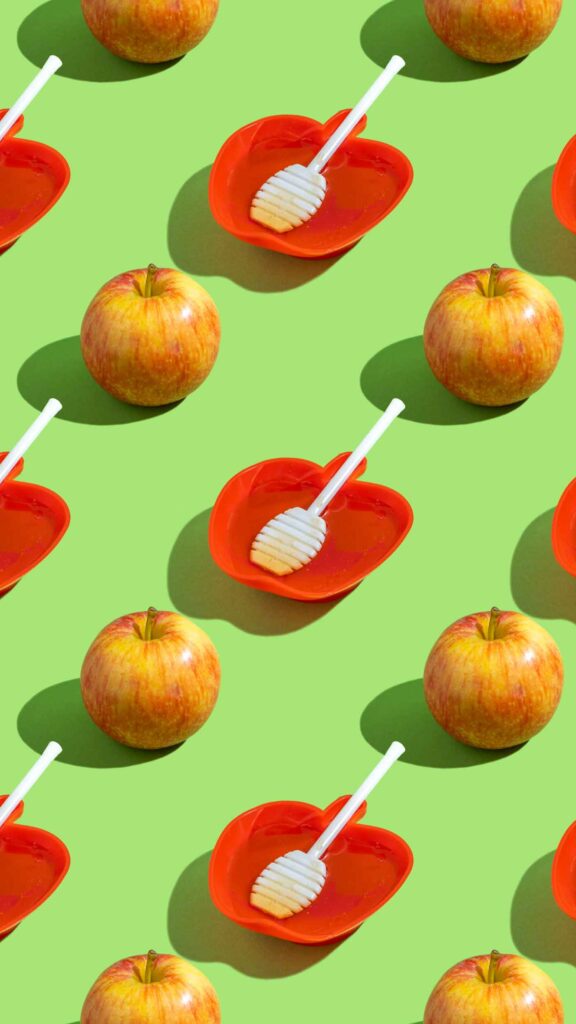rosh hashanah essentials
food (AND drink)

Next up, round challah. Instead of the typical braided loaf you might see on a regular Shabbat, Rosh Hashanah challah is round. This isn’t just a fun shape — it symbolizes the circle of life, a reminder of the cyclical nature of time. It’s also a visual representation of the continuity of our traditions and the coming year. Some people like to add raisins to their round challah, which is a nice touch if you’re into that sweet, fruity flavor. But if you’re not a fan of raisins (who has time to pick those little things out of their bread?), it’s totally okay to skip the round version or go for one without the raisins. Either way, it’s a perfect addition to the festive meal.
And then there’s pomegranate. If you’ve ever been to a Rosh Hashanah meal, you’ve probably seen a pomegranate on the table. It’s a symbol of abundance and fertility, but more importantly, it represents the hope that our good deeds in the coming year will be as plentiful as the seeds inside the fruit. Some people even eat the seeds for a sweet, juicy reminder of that abundance. Fun fact: Some say the pomegranate has 613 seeds, matching the 613 commandments in the Torah. Whether or not that’s true, it’s a beautiful symbol of hope and good intentions.
Now, let’s talk about carrots. Specifically, tzimmes — a traditional sweet carrot stew, sometimes with sweet potatoes and prunes. Why carrots? Because they look like coins! Eating carrots on Rosh Hashanah is a way of hoping for wealth and prosperity in the year to come. And if you’re cooking up a big batch of tzimmes, it’s kind of like doubling down on those wishes. Plus, it’s sweet, so it fits right in with the “sweet year” theme.
Let’s not forget fish. Some families have the tradition of eating the head of a fish (yes, really!) to symbolize the hope that we’ll be “the head, not the tail” in the year ahead. It’s all about leadership, not following behind. If you’re not feeling up to chomping down on a fish head, don’t sweat it — many people opt for just a nice piece of fish, like salmon. It still gets the message across.
For those with a sweet tooth, dates are another Rosh Hashanah favorite. The date is a symbol of wishing for a year free of enemies, as the word “date” (in Hebrew, “tamar”) is thought to be related to a word that means “end” or “finish.” It’s kind of like saying, “May we put all our struggles behind us and have a smooth year ahead.” Plus, dates are just delicious, so it’s an easy win.
Lastly, let’s talk about kugel. The beloved noodle or potato pudding that graces many Rosh Hashanah tables. Whether it’s sweet or savory, kugel is a holiday staple. If you’re lucky enough to have a grandmother who makes it from scratch, then you know it’s basically the best part of the meal. The layers of crispy edges and creamy inside are a texture lover’s dream, and it’s often flavored with a bit of cinnamon or nutmeg to keep in line with the holiday’s sweet theme.
So there you have it: apples, challah, pomegranates, carrots, fish, dates, and kugel — a spread full of meaning and flavor. Whether you stick to the basics or go all out with a full-on festive meal, just remember that Rosh Hashanah is a time for renewal, reflection, and, most importantly, sharing a meal with loved ones. L’shanah tovah — to a sweet, sweet new year!

Peek Inside our
Free Booklet
Our booklets can take you from zero to hero! They are full of relatable, occasionally funny, and always meaningful resources to connect you to Judaism.